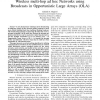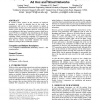123
Voted
VTC
2010
IEEE
14 years 11 months ago
2010
IEEE
—Most of geographic routing approaches in wireless ad hoc and sensor networks do not take into consideration the medium access control (MAC) and physical layers when designing a ...
120
Voted
IJSNET
2007
15 years 16 days ago
2007
: Most wireless ad hoc sensor networks are susceptible to routing level attacks, in which an adversary masquerades as a legitimate node to convince neighbouring nodes that it is th...
131
Voted
JPDC
2006
15 years 17 days ago
2006
An important problem in wireless ad hoc and sensor networks is to select a few nodes to form a virtual backbone that supports routing and other tasks such as area monitoring. Prev...
116
Voted
CORR
2007
Springer
15 years 18 days ago
2007
Springer
In recent years, the proliferation of mobile computing devices has driven a revolutionary change in the computing world. The nature of ubiquitous devices makes wireless networks th...
121
Voted
CORR
2010
Springer
15 years 21 days ago
2010
Springer
-- In cluster-based routing protocol (CBRP), two-level hierarchical structure is successfully used to reduce over-flooding in wireless ad hoc networks. As it is vulnerable to a sin...
114
Voted
ICDCS
2010
IEEE
15 years 2 months ago
2010
IEEE
Abstract—Coverage problem is a fundamental issue in wireless ad hoc and sensor networks. Previous techniques for coverage scheduling often require accurate location information o...
120
Voted
ICCCN
2007
IEEE
15 years 4 months ago
2007
IEEE
A new physical layer technique [1] for broadcasting in multi-hop wireless ad hoc networks makes broadcast a much more efficient building block than traditional flooding broadcast. ...
110
Voted
MOBIHOC
2003
ACM
15 years 5 months ago
2003
ACM
In scenarios where wireless ad hoc networks are deployed, sometimes it would be desirable that ad hoc nodes can communicate with servers in wired networks to upload or download da...
103
Voted
DIALM
2003
ACM
15 years 5 months ago
2003
ACM
In this paper, we study an algorithmic model for wireless ad hoc and sensor networks that aims to be sufficiently close to reality as to represent practical realworld networks whi...
LCN
2003
IEEE
15 years 5 months ago
2003
IEEE
In this paper, we introduce statistical methods to estimate the stability of paths in a mobile wireless ad hoc environment. Identifying stable paths helps to reduce control traf�...


